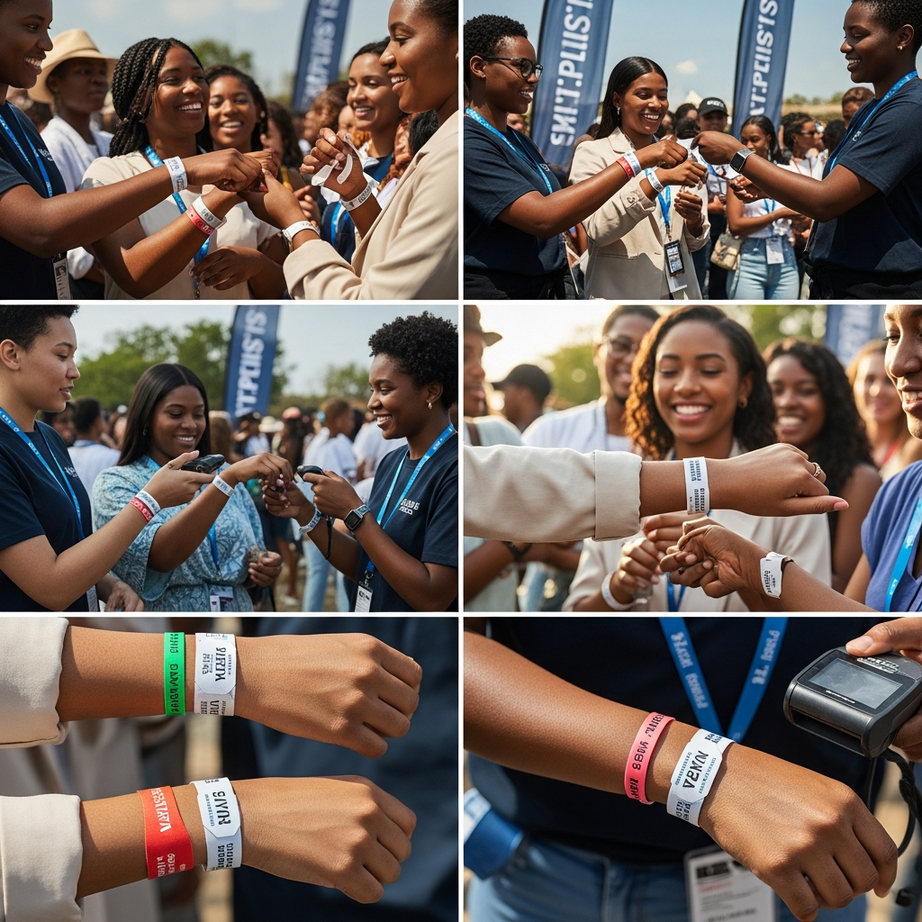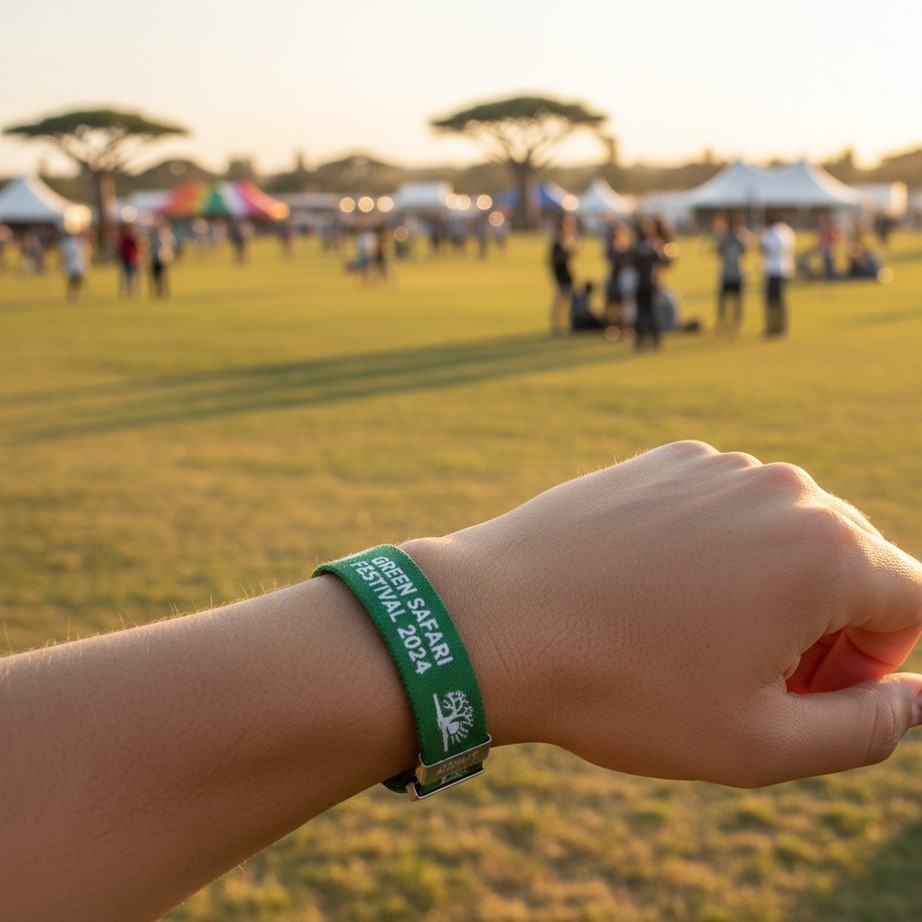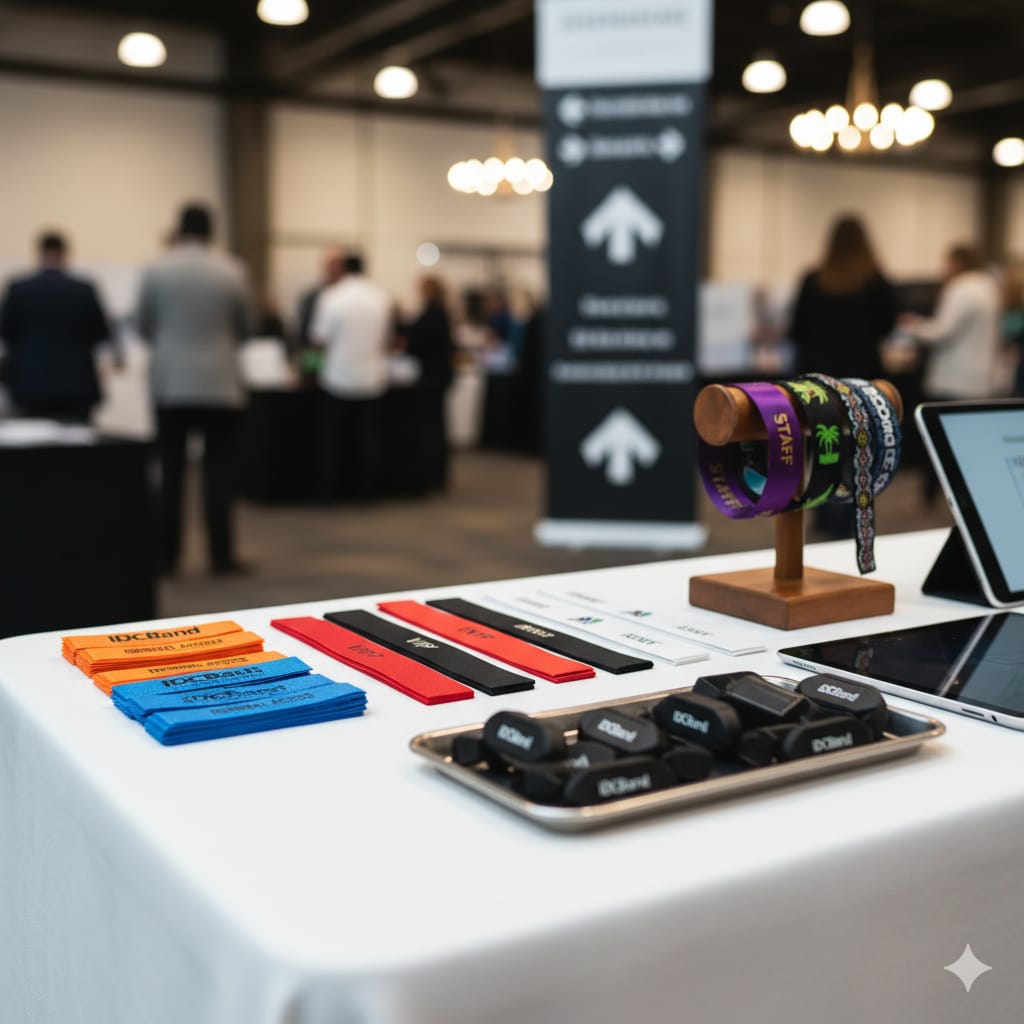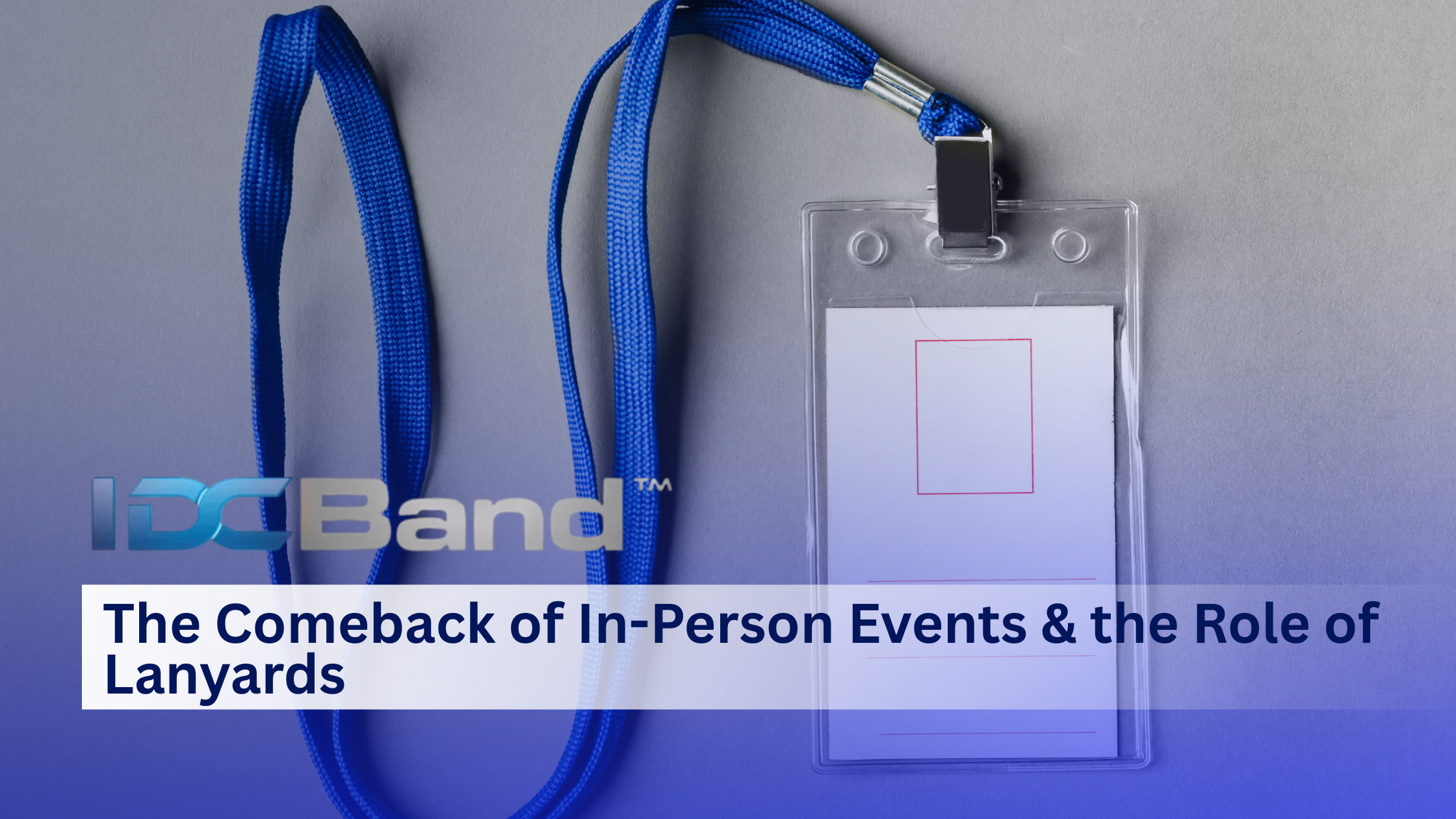What Are Tyvek Wristbands and Why Are They Used
Tyvek wristbands are lightweight, tear resistant wristbands made from a synthetic material that looks like paper but acts more like plastic. They are designed for short term use and are commonly used at events where fast identification, basic access control, and crowd flow are important. These wristbands are widely seen at concerts, sporting events, school outings, festivals, markets, fundraisers, and corporate functions. They are popular because they are easy to use, budget friendly, and secure enough for short use periods.
How Tyvek Wristbands Are Made
Tyvek is made from high density polyethylene fibres that are spun into thin sheets using heat and pressure. The result is a flexible but strong material that is water resistant and hard to tear. Once the sheets are ready, they are cut into strips shaped for the wrist. An adhesive closure is applied to one end and security cuts are added to prevent tampering. From there, wristbands can either be left plain or printed with custom text and graphics.
What Makes Tyvek Wristbands Unique Compared to Other Materials
Unlike fabric or silicone wristbands which are better for long term use, Tyvek is designed specifically for short term needs. It feels light and breathable, which makes it comfortable even in hot or humid conditions. The material is strong enough to resist most attempts to tear or stretch it off the wrist, but thin enough to feel like you are not wearing anything heavy. It offers a nice balance between cost and function.
When to Use Tyvek Wristbands at Events
These wristbands are ideal when you need a simple way to identify guests or staff for a day or two. They are common at music shows, sporting events, school field trips, expos, and pop up events. If you are running a venue or managing an area with restricted access, they work well to indicate who should be there and who should not. They are also useful when you need different categories of attendees such as general access, backstage, VIP, or staff.
Different Types and Styles of Tyvek Wristbands
Tyvek wristbands come in a wide range of colours and finishes. Some are fluorescent, others are solid colours, and you also get patterned or themed options. Some may have numbered sections or tabs for raffles or drinks. Others might come with barcode or QR code printing for basic scanning. The plain wristbands are the simplest and are often used in schools or quick entry setups. Printed wristbands are more common for organised events where branding or messaging is needed.
Understanding the Sizing and Fit
Most Tyvek wristbands are one size fits most. They usually measure about 25 millimetres wide and just under 260 millimetres long. The design includes an adhesive area that sticks to itself and adjusts to different wrist sizes. Once it’s on, it stays in place comfortably for the full day. It is not recommended to try and use the same wristband again once removed as the adhesive weakens and the paperlike surface may tear.
How Long Tyvek Wristbands Last
Tyvek wristbands are designed to last for a day or two. They are water resistant and hold up well during activities like walking, dancing, or light sport. They are not meant for weeklong festivals or multiday conferences where repeated exposure to water and wear might cause damage. For one day events or two day setups, they perform well and remain readable and intact.
Water Resistance and Weather Considerations
Even though Tyvek looks like paper, it can handle water quite well. People often wear them while sweating or in light rain without issue. They are not meant for swimming or full submersion, but they dry quickly and won’t fall apart in the rain. This makes them great for outdoor setups, sports fields, and open air events where conditions might change during the day.
Security Features and Tamper Proof Design
One of the biggest reasons people choose Tyvek wristbands is the tamper proof adhesive. Once the band is closed, it cannot be removed without breaking it. This prevents people from trying to transfer wristbands or reuse them. Some versions have additional security cuts which tear easily if someone tries to peel the band open. That means once it is on, it stays on until the event ends.
Customisation Options and Their Purpose
Custom wristbands help organisers with branding or communication. You can print the name of the event, logos, taglines, or important instructions right on the band. This is helpful when staff need to quickly scan a crowd and see who should be where. Custom colours and designs also stop people from bringing in lookalikes. For example, if you use green for Friday and blue for Saturday, it is easy to see who has the right wristband.
Printing Techniques Used for Tyvek Wristbands
The surface of Tyvek allows for clear printing using direct thermal or digital print methods. Colours show up clearly and text stays readable for the duration of the event. You can print simple logos, barcodes, or event names. It is best to keep designs bold and easy to read from a distance. Complex images or fine lines may not show up well on the slightly textured surface.
Why Colour Matters When Choosing a Wristband
Colour plays a big role in wristband visibility and access control. Bright colours like yellow, orange, or neon green are easy to spot in a crowd. Darker colours might be used for VIP or backstage access. Some organisers use one colour for each type of attendee, such as guests, vendors, security, or performers. This avoids confusion and helps with managing large crowds.
How to Match Wristband Colours to Event Types
Different colours can be matched to the mood or theme of an event. For a school sports day, you might use team colours. For a wedding function, you may go with subtle tones. Festivals might use a mix of bright colours and fun patterns. The goal is to help both staff and guests instantly understand what the wristband means. Choosing the right colour helps keep things organised without needing to ask too many questions.
Using Tyvek Wristbands to Control Entry and Access
Wristbands are used at entry points to show that someone has paid, checked in, or has the right to be there. This is faster than checking names or scanning codes for everyone. At the gate, staff simply wrap a band around each person’s wrist and that becomes their pass. No one can re enter without a wristband, and anyone inside without one is quickly spotted.
How Organisers Use Them to Improve Queue Flow
Wristbands help reduce queues and speed up check in. Instead of asking for proof of payment or printing tickets for each area, one wristband does the job. For example, a colour coded system might allow guests to enter the food area, skip long lines, or move between zones without any hassle. This makes it easier to manage space and time across large areas.
Wristband Colour Coding for Staff, Guests, and VIPs
Using different colours for each group of people keeps things simple. Staff might get red, general guests yellow, and VIPs blue. This allows quick identification at a glance. If an issue comes up or someone needs help, it is easier for security to see who is who. It also limits access to private or restricted spaces.
Are Tyvek Wristbands Recyclable or Eco Friendly
Tyvek is made from plastic based fibres which are technically recyclable, but not all recycling facilities accept it. While it is not as eco friendly as fabric or reusable wristbands, it creates very little waste when used in bulk. One wristband per person per day is still lighter on the environment than plastic lanyards or laminated passes. If possible, check with local recycling services to see if they accept the material.
How to Store Wristbands Before the Event
Store wristbands in a cool, dry place away from sunlight. Keep them flat or in their original packaging to avoid damage. Humid conditions may weaken the adhesive or make printing less sharp. Sort them in advance by colour or date to avoid delays during the event.
How to Apply a Tyvek Wristband Properly
Wrap the wristband around the wrist, stick the adhesive end on the opposite side, and press firmly for a few seconds. Do not make it too tight. It should sit comfortably but not slide off. Avoid putting it over sleeves or jewellery.
Removing Tyvek Wristbands Without Damaging the Wrist
To remove the band, use scissors to cut it from the underside of the wrist. Do not try to rip it off as it may cause skin irritation. Avoid pulling it too hard or trying to peel the adhesive since that will usually result in tearing.
What Happens When Someone Tries to Transfer a Wristband
Once a Tyvek wristband is applied, it cannot be taken off without showing signs of tampering. If someone tries to remove it and stick it onto someone else, the adhesive fails and the material usually tears. This prevents unauthorised transfers or re entry attempts.
What to Do If You Run Out of Wristbands at an Event
Always keep extra bands on hand in case of last minute guests or volunteers. If you run out, use a different colour and update your team on the change. Avoid reusing or taping broken bands as this can cause confusion and security gaps.
Can You Write on Tyvek Wristbands
Yes, you can write on them with a permanent marker. This is useful for numbering, adding names, or making special notes. It works best on plain bands with no print. Let the ink dry fully before use.
The Difference Between Plain and Printed Wristbands
Plain wristbands are usually cheaper and faster to use but do not offer much in terms of branding or communication. Printed bands look more professional and help with identification. They are better for larger or more organised events where presentation matters.
When Tyvek Wristbands Are Not the Best Option
If your event runs for more than three days or involves heavy water exposure, Tyvek might not hold up. Fabric or silicone bands are better for long use or daily wear. Tyvek also does not work well when you need to scan access or re use the wristband.
Comparing Tyvek to Fabric Silicone and Vinyl Wristbands
Tyvek is best for short term use. Fabric and silicone are softer and meant for longer wear. Vinyl sits somewhere in the middle with higher durability and a slick look. Tyvek wins on cost and ease of use for one or two day needs. The other options are better when comfort or multi use is more important.
Common Mistakes People Make With Tyvek Wristbands
People often make the band too tight or too loose. Others try to reuse a broken band. Some try to write on glossy printed areas where ink smudges. Another mistake is applying them before sorting the guest list, which slows down entry. Avoid these by preparing ahead of time.
What Not to Do When Applying or Using Them
Do not let guests apply their own bands. Do not apply bands to wet or oily skin. Avoid overlapping the printed area with the adhesive. Do not store bands in hot cars or damp rooms. Do not switch wristbands between days unless you change colours.
How Bulk Orders Usually Work
Wristbands are often packed in boxes of 500 or 1000. Plain ones ship faster, while printed ones take a few extra days. It is common to mix colours in one order. Always order more than needed in case of mistakes or added guests.
Tips to Make Tyvek Wristbands Last the Entire Event
Apply to dry skin. Press the adhesive well. Avoid pulling on the band. Choose simple, bold printing for better visibility. Store unused bands properly. Remind guests not to tamper with their wristbands.
How to Store Leftover Wristbands for Future Use
Keep unused bands in a sealed plastic bag in a cool cupboard. Do not expose them to heat or moisture. Do not bend or crease them. Label them by event or colour to avoid mix ups later.
What to Do With Extra Wristbands After the Event
Store them for future use if they are plain. If they are printed with dates or event names, consider recycling them. Do not reuse wristbands that were already applied.
Real World Examples of Event Types That Rely on Tyvek Wristbands
Sports days, music shows, flea markets, fun runs, school camps, corporate activations, church gatherings, and pop up experiences all use Tyvek wristbands. The goal is fast access and clear identification.
How Tyvek Became a Standard in the Event Industry
Over time, Tyvek replaced paper and cloth tags for single day events. Its mix of strength, price, and comfort made it an easy choice. As events grew, the need for fast and visible guest control led to the wide use of Tyvek wristbands.






